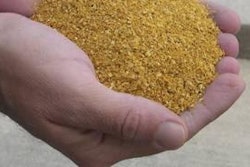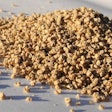
Concerns about the environment, as well as a desire to grow and use feed more efficiently, are the driving forces behind a new project to reduce diffuse phosphate pollution by developing new improved wheat lines.
The partners behind this ground-breaking research include scientists at the UK’s University of Reading and the National Institute of Agricultural Botany (NIAB), the University of Nottingham and Harper Adams University College, who are collaborating with researchers from the University of Idaho in the US.
They are being supported by several allied industries, including Cargill, Sun Valley Foods, AB Agric Ltd, JSR Farms Ltd, Frank Wright, the British Poultry Council and the British Pig Executive (BPEX).
The aim of the project is to provide adapted germplasm and tools for marker-assisted breeding of Highly Available Phosphate (HAP) wheat that will have the potential to significantly reduce diffuse P pollution when used in pig and poultry diets.
The scientists are also hoping to determine the effect of P fertiliser treatment on the P metabolism within the wheat plant and grain, as well as on the grain composition of other important nutrients and micronutrients.
Led by NIAB, the consortium has already initiated the production of wheat germplasm with low phytate content in the grain, thus increasing the bio-availability of phosphate to monogastric animals. This should, in turn, reduce the level of phosphates entering the environment from animal wastes.
A spokesman for the consortium explained that they were mapping the genes involved in this process in an effort to learn more about the plant physiology underlying the changes in phytate content, together with related mineral nutrition.
The precise effect of changes in feed quality will be assessed through controlled pig and chicken feeding studies using the newly identified low phytate lines.
Recent data has shown that while the addition of microbial-derived phytases to pig diets can help reduce P excretion by pigs, there is still scope to further reduce diffuse P pollution from pig enterprises by using Highly Available Phosphate (HAP) wheat in the diets.
The major form in which phosphorous occurs in plants is myo-inositol -1,2,3,4,5,6-hexakisphosphate, commonly referred to as phytic acid, inositol, or InsP6; it is an important anti-nutritional factor for farm animals because of its ability to form a compound with micro-nutrients such as iron and zinc.
Microbial-derived phytase that can be added to the diet of pigs and poultry is produced on a commercial scale as part of the large feed enzyme market because the exogenous phytase provides an effective means of breaking down the phytate in plant-derived feeds, allowing the animals to use more P and other minerals and proteins, rather than excreting them.
Good precedents
By using a careful balance of nutrients combined with phytase (together with other measures), the livestock industry in the Netherlands has managed to halve the amount of P excreted by growing and finishing pigs over the past 20 years.
Taking the UK, which currently has some 500,000 sows, as an example, the consortium’s spokesman pointed out that wheat could constitute up to 60 per cent of the country’s pig and poultry diets.
A variety of HAP wheat with similar performance characteristics to conventional wheat would ensure that the entire requirement in the diet of monogastrics was met without the need to add supplementary phosphate.
Ideally, it was hoped that the new HAP wheat could also be used in conjunction with commercially produced phytase to further reduce the release of P into the environment, since there was evidence to suggest that they could interact in a positive way.
Encouraging results
In fact, initial stages of this research project have already revealed the expected potential reduction possible in diffuse P pollution from HAP wheat is in line with that demonstrated for HAP maize and barley. Pigs fed with the HAP maize reduced P excretion by 18 per cent and by 16 per cent when they were fed with HAP barley.
In collaboration with the University of Idaho, researchers at NIAB have already been successful in developing several new wheat lines in which phytic acid P represents only 42 per cent of seed total P, compared with 74.7 per cent of seed total P in the spring-sown control.
This has resulted in a significant increase (more than 35%) in the amount of phosphate that is available to a monogastric animal – and it is anticipated that this will lead to a major reduction in input costs and the environmental impact.
This research is considered to be extremely important for some European pig and poultry farmers, because new Integrated Pollution Prevention and Control (IPPC) legislation and the European Union’s tough Water Framework Directive restricts them spreading muck on fields and threatens their size and viability which they have traditionally maintained by maximising the economies of scale.






